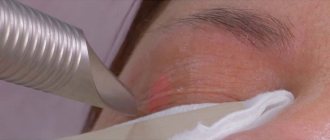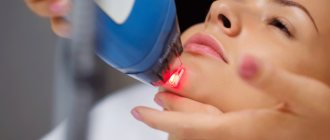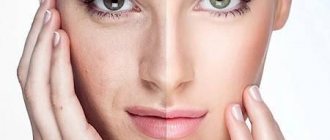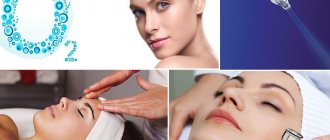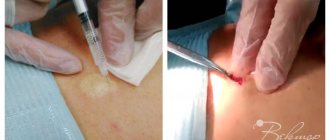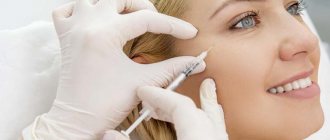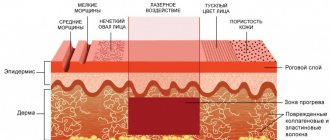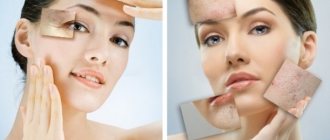The mechanism of fractional thermolysis - pulsed laser energy causes controlled evaporation of the skin in accordance with the principles of selective photothermolysis. Clinical manifestations of laser treatment depend on the skin's ability to self-rehabilitate.
Following the evaporation of disorganized epidermal cells, the formation of well-organized keratinocytes occurs, paralleling the structural reorganization of collagen and elastin in the upper papillary dermis, resulting in an improvement in the appearance and texture of the skin. 50% of patients notice this in the early period.
Collagen remodeling and further clinical improvement often continues for up to 18 months after CO2 laser resurfacing.
Fractional CO2 laser evaporates the surface layer of skin, and new, smooth skin is formed in place of the evaporated epidermis. The laser causes thousands of micro-point injuries, leaving untouched tissue between them, which reduces the rehabilitation period.
Also, the CO2 laser affects collagen fibers by heating them and contracting them, which leads to a tightening effect. Thermal exposure leads to the process of formation of new collagen fibers - neocollagenesis, which allows you to observe an increasing rejuvenating effect for at least 6 months.
Rehabilitation period
The rehabilitation period is individual for different patients, on average it ranges from 5 to 7 days. During this period, the patient loses social activity.
Immediately after the procedure and during the first 24 hours, the skin is red and swollen. On the second day, swelling increases, especially in the eyelids and lower third of the face. Wrinkles and folds become more pronounced.
By the third day, sometimes by the fourth day, the swelling subsides. On the third or fourth day, large-plate peeling appears. You should not remove the crusts yourself. Everything should happen naturally.
By the sixth day, the peeling stops. Slight redness of the skin persists. This flaw can be masked with foundation. To prevent the formation of pigmentation and scarring, it is important not to ignore the doctor’s recommendations. Decorative cosmetics can be used 5-6 days after the procedure. For 3 months, use creams with a photoprotective factor SPF of at least 30+.
Features of ablative resurfacing using the CO2RE laser
The main difference between CO2RE (Candela)
compared to other similar lasers on the market -
the shortest possible pulse.
The shorter the impulse, the less tissue overheating, the more effective the procedure and the more comfortable the rehabilitation.
Of course, rehabilitation can only be called relatively comfortable - this is not Fraxel re:store DUAL, when you can calmly return to your normal lifestyle in a few days. Clinical rehabilitation, during which swelling and crusting disappear, lasts on average from 7 to 14 days. With deep grinding, slight redness can persist for up to one and a half months. It is easily corrected with tonal means and does not affect the patient’s social life in any way. It is equally important that the procedure with CO2RE is much easier to tolerate than with other ablative lasers .
As for the intervals between procedures, there are no clear recommendations. There is no such rule “you have done one procedure, the next one must be done exactly one month later.” Everything is determined individually, taking into account tissue restoration. For example, on the body it occurs more slowly than on the face - this is due to blood supply. A lot depends on the structure of the skin. If it is thin and atrophic, then the renewal process will take much longer. In this case, replenishment with biorevitalizants is necessary. Otherwise, the skin will recover very poorly. You should always adhere to the golden rule - any negative stimulus associated with skin damage must be combined with a positive one that improves its condition. Is it possible to do the procedure more often than once every six months? Hypothetically it is possible, but not earlier than in 1.5 months. Completely on the face or on some problem area. For example, if you performed the first procedure in November, you can safely repeat it in January.
All CO2 lasers increase photosensitivity , which means you need to be very careful with tanning after the procedure. Especially for those patients who are prone to hyperpigmentation. If such a patient had CO2 resurfacing and after 2 weeks went south, then it is 100% that we will get pigmentation. That is why this procedure is done only in the autumn-winter period. For a month after the procedure there should be no tanning: solarium, trips to countries with active sun (including to a ski resort).
CO2 laser has a fairly wide range of applications.
First of all, we prescribe it for rejuvenation, when it is necessary to remove excess skin. The procedure is suitable for almost all areas. Of course, such delicate areas as the neck and mammary glands require a special approach: lower, universal parameters are used. We select parameters for each patient individually, taking into account his characteristics and goals. It is this scheme of ablative resurfacing that gives the maximum result.
It is necessary to clearly understand that with the help of a CO2 laser we can tighten the skin, significantly reduce the depth of wrinkles, and eliminate dyschromia. However, if there are pronounced age-related changes (severe ptosis, sagging soft tissues, and even more so sagging muscles), no laser can eliminate this - such problems are already solved by plastic surgeons. If we are faced with the task of tightening the skin, then the CO2RE laser has no equal. We get qualitatively different skin: it becomes elastic, there are significantly fewer wrinkles, the skin texture is evened out, the pores are narrowed. The patient will be able to evaluate the first result associated with ablative resurfacing (“evaporation” of the skin) no earlier than a month after the procedure. This initial cosmetic effect is slightly offset by the presence of swelling and redness. We get the effect associated with collagen production after about six months, that is, it is cumulative.
Post-acne – for many patients this is a serious problem not only of an aesthetic, but also a psychological nature. Previously, we could not help them . With the advent of CO2RE, the situation has changed radically. The clinical result from its use is incomparable with any other lasers: not only non-ablative, but also ablative. With CO2 resurfacing, even old post-acne scars can be removed (it is believed that those that are no more than six months old can be corrected better, but this is rare - usually people come to us with old ones). In fact, ablative resurfacing can work with any scars: post-acne, post-burn, post-inflammatory (naturally, not in the phase of active inflammation).
Several lasers can be used to eliminate stretch marks - Fraxel re:store DUAL and CO2RE . On Fraxel we work using deep parameters, but the effect of such a procedure is much lower than on CO2 (after all, this is a non-ablative technique). I want to emphasize that even with the new CO2RE laser, several procedures are necessary to completely get rid of stretch marks. You shouldn’t expect maximum results from one.
Sharp changes in skin tone are associated not only with age-related changes, but also with strong fluctuations in weight. For example, after childbirth. If during pregnancy a woman had a large belly with a fairly small thickness of fiber, there is a high probability that the skin will stretch greatly. CO2 laser resurfacing copes well with changes in skin tone: sagging, moderate stretching. I want to emphasize that no hardware technique can replace plastic surgery. If there is a muscle strain (divergence of the rectus abdominis muscles), severe stretching of the skin (when it “hangs” like a pouch), we cannot do anything - these are direct patients of plastic surgeons. Another delicate area on the body that is usually difficult to correct is the inner surface of the shoulders. This area suffers greatly, primarily due to age-related changes. To tighten and tighten the skin and rejuvenate, you can also use ablative resurfacing with CO2RE. With relatively little rehabilitation, we achieve good results that we cannot obtain with non-ablative lasers.
CO2 ablative resurfacing is a serious procedure. Of course, it is cosmetological, but it requires certain skills and experience from the doctor. Only the correct purpose of the procedure, the correct choice of parameters and the correct management of the patient after it helps to avoid negative consequences or stop them.
Main effects after the procedure
Pronounced tightening and reduction of excess skin, smoothing of wrinkles, reduction of pigment formations. As well as smoothing atrophic scars and reducing pigment spots after acne.
Fractional CO2 resurfacing goes well with other procedures; a course of deep skin hydration, the so-called “biorevitalization,” is especially suitable. This procedure will perfectly moisturize the skin and help faster recovery after aggressive exposure.
The laser resurfacing method has also proven itself well for the treatment of stretch marks (stretch marks) of various etiologies on any part of the body. The procedure showed excellent results, rehabilitation proceeds a little faster than on the face without loss of social activity.
Skin aging processes and their causes
The condition and appearance of the skin is determined by the rate of renewal of its cells and connective tissue fibers, as well as the degree of hydration of all its layers. Fibroblasts are responsible for the synthesis of collagen and elastin in the dermis. And the continuous renewal of the epidermis is ensured by the presence of stem cells in it, which are actively dividing.
Cytokines, biologically active molecules that regulate the activity of cells and force them to work in harmony, have a stimulating effect on tissues. Cytokines determine cell survival, division, growth and functional activity. These molecules are quickly transferred from one cell to another, causing a “cascade” of changes.
Age-related changes are caused by a general slowdown in blood circulation and metabolism in tissues, a decrease in the rate of cell division, and their synthetic activity. For example, the collagen content in the dermis, starting from the age of 25, decreases at an average rate of 1% per year. The quality of collagen also decreases. It becomes loose and cannot provide the same skin tone. The concentration of hyaluronic acid decreases, the amount of which determines the level of skin hydration and the activity of fibroblasts and other cells.
An additional aging factor is ultraviolet radiation, under the influence of which the elastin and collagen fibers are destroyed, which provide skin elasticity, dilation of superficial vessels with the formation of spider veins and mesh. The protective reaction of the skin in the form of the production of additional melanin and an increase in the number of layers of epidermal cells causes the appearance of age spots and uneven complexion.
The result of all these internal processes are the external manifestations of aging:
- loss of elasticity and firmness of the skin, drooping of the soft tissues of the face with the formation of nasolabial folds, “jowls” in the cheek area, and unclear facial contour;
- dynamic and static wrinkles;
- uneven skin color with areas of hyperpigmentation;
- the appearance of telangiectasia;
- decrease in tissue moisture level.
In order to rejuvenate the skin, we must eliminate all of the above external changes. In order for the result of the anti-aging effect to be long-lasting, it is also necessary to restore the normal level of metabolic processes.
The fractional laser facial rejuvenation procedure allows you to solve both problems as follows:
- tissues affected by age-related changes are removed using a controlled damaging effect, allowing the preservation of stem cells;
- the intensity of the damaging effect should be such as to activate the restoration of the skin, accelerate metabolism and the process of cell division.
Benefits of Fractional Laser
If you compare photographs of the same person before and after the laser, it becomes clear why reviews about this procedure on the Internet are full of enthusiastic statements. The comparison shows the consequences of how all sorts of defects disappear from the face. It quickly becomes soft and velvety. There are clear signs that indicate that there is rejuvenation of the skin.
photos before and after using fractional laser
The advantages of the technique that uses a CO2 laser include the following details:
- The effect achieved by skin resurfacing is visible almost immediately.
- The procedure is actually not only very effective, but also extremely safe.
- The use of this technique allows for complete renewal of the skin in the shortest possible time with minimal financial costs.
- Working with a laser eliminates contact with the surface, which prevents infection with infectious diseases.
- The laser acts strictly on a certain depth of tissue, which guarantees the desired effect.
- Laser irradiation acts as a stimulator to actively strengthen collagen fibers with new cells.
- The laser easily deals with fine wrinkles around the eyes and lips, which surgery cannot cope with.
- This method easily copes with a number of neoplasms on the skin of the face and body, such as papillomas, warts, stretch marks, scars and others.
- The laser beam eliminates pigment spots.
- Using a laser beam, it is easy to polish the skin in the neck and, naturally, décolleté area, which is very difficult when using other methods.
- Rehabilitation is quick and painless, as minimal care is required.
- There are no contraindications (except pregnancy and lactation) and no side effects.
What is the result of fractional rejuvenation?
After a course of 3-5 Fraxel treatments, the skin will become elastic and beautiful.
Since Fraxel is a procedure that stimulates the formation of new, blemish-free skin, the results of rejuvenation will last for many years. And scars and stretch marks will disappear forever.
It is noteworthy that Fraxel does not radically change the appearance. Natural features are preserved, they simply return to the state they were 5-10 years ago. Among all hardware rejuvenation procedures, this is one of the highest rates.
How does the procedure work?
- Before laser facial resurfacing, the nurse applies local anesthesia so that the procedure does not cause discomfort to the patient;
- the doctor selects laser settings depending on the task (skin rejuvenation or scar removal) and the treatment area;
- the doctor puts on special glasses for himself and the patient, begins the laser resurfacing procedure;
- After the end of the session, the doctor treats the treatment area with an antiseptic and a special cream containing dexpanthenol, gives recommendations and sends the patient home.


